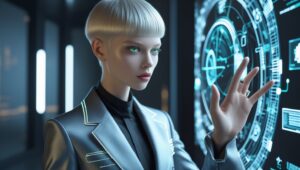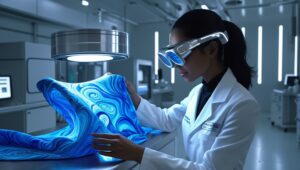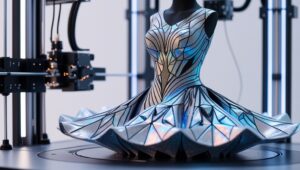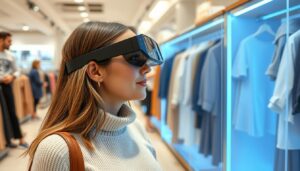Exploring the Intersection of Fashion and Technology. We now find the fashion and technological industries interlinked, through the design of AI fashion wear and even health monitoring devices disguised as clothing. Innovation is changing how we create, wear, and shop for clothes tremendously.
The past decade saw the birth of smart fabrics, fashion 3D printing, AI designs, metaverse digital fashion, and much more. Technological advancement combined with fashion has improved sustainability efforts along with custom shopping experiences, giving birth to infinite possibilities.

This article reviews the impact and shaping of the fashion industry through modern technology along with the consequences and possibilities their futuristic inventions might bring to its consumers and brands.
Evolution of Fashion Technology:
Style, as we probably are aware, has consistently continued to advance with the modification of innovation by setting new principles for how garments are planned, made, and, surprisingly, worn.
The Early Days: Handmade to Industrial Revolution
Clothes previously were handmade without the aid of machinery, which required time and skilled artisans. This process resulted in each garment being limited and very expensive, meaning the majority of a non-custom-tailored population could not afford them.
Exploring the Intersection of Fashion and Technology. The modern insurgency of the eighteenth to nineteenth century denoted the presentation of automated material creation, sewing machines, and engineered colors. This enabled mass production through factories, which made fashion accessible and affordable to the public.

The 20th Century: Rise of Fast Fashion
The rise of engineered materials, for example, polyester and nylon, made the development of pieces of clothing less expensive. In the late twentieth hundred years, the idea of quick style was conceptualized. Shops like H&M and Zara advocated the business by selling chic garments at efficient costs.
Nonetheless, the concern about the pollution caused by fast fashion raised the alarm, and this resulted in the demand for sustainable fashion alternatives, which technology is now beginning to assist in expediting.
The Digital Transformation of Fashion:
At present, fashion is synonymous with technology. Every sphere of the industry has been fundamentally altered as a result of it:
- Artificial intelligence and machine learning software designs and estimates evolving trends.
- 3D printers enable design customization and pollution-free garment manufacturing.
- Wearable tech, including self-heating jackets and smartwatches, improves functionality.
- Augmented Reality and Virtual Reality enable immersive experiences when shopping.
Currently, technology is an essential component of the fashion industry. It is evolving all the aspects of the industry.
Smart Fabrics and Wearable Technology:
Fashion is not just about looking good anymore; functionality is equally important. Wearable technology and smart fabrics have changed the way we experience clothing.
What Are Smart Fabrics?
Smart fabrics, likewise, alluded to as e-materials, are upgraded materials that have electronic parts consolidated inside them.
These fabrics can:
The importance of technology in improving daily activities cannot be understated. The rise of new technology has given way to advanced gadgets for everyday tasks like checking one’s speed while running to monitoring heart rates, hydration, and temperature to help with personal fitness. All of this can now be revamped with Assist-enabled Pentagon+ Smart Trackers. These devices now allow real time feedback during exercises which can help improve results. Other features include built-in emergency lights or alerts to enhance safety.

Wearable items that incorporate technology are endless. One example is smartwatches such as the Apple Watch and Fitbit. These function as both accessories and stylish health trackers. Other examples are self-heating jackets by OROS and Columbia that are perfect for freezing temperatures. They have also devised biometric clothes like smart shirts and leggings, which help track muscle movement and breathing patterns and help athletes maximize their performance.
Exploring the Intersection of Fashion and Technology. With the increase of these items, we can expect the invention of new gadgets that will help better our lives. Some examples are mood-responsive clothes, kinetic energy-powered outfits that can charge devices, or even garments that monitor our health and inform the doctor in case of emergencies. Wearable items have more purposes than just being fashionable; they increase life quality while looking appealing.
AI-Powered Fashion Design:
Designing a fashion collection was done traditionally with the aid of experience and intuition, but nowadays with tools like IBM Watson and Adobe Sensei at hand, designers have assistance in:
- Creating odd patterns by examining previous fashion.
- Understanding what the most sought-after style is will be checking social media.
- Estimating recommendations according to what people browsed.
Some of the AI-powered tools include:
- The Fabricant – a fashion house that specializes in the creation of AI-constructed hyper-realistic apparel.
- Stitch Fix – Uses AI recommendation tools to prepare personalized outfit sets for clients.
- Zalando’s AI Fashion Designer – an automated style generator that creates new garments based on the trends noticed.
How Machine Learning Aids Trend Prediction:
Exploring the Intersection of Fashion and Technology. The AI scans millions of posts and pre-existing fashion blogs and search queries to figure out the newest trends before they are known. Companies like H&M and Zara utilize AI to figure out which colors and patterns are becoming popular, what certain influencers and superstars are wearing, and how customers’ choices change with time.
Using this method helps brands be ahead of the trends instead of being in catch-up mode and helps in curbing wastage and overproduction.
Will AI Replace Human Designers?
Even though AI assists designers with fashion, creativity is a uniquely human trait. Rather than replacing designers, AI is an added tool that helps a company make data-driven choices while still remaining as creative as the designer desires.
3D Printing and Customization:
It changes style’s way to deal with configuration by giving open doors to unrivaled customization, ecological kind disposition, and speed.

The Influence of 3D Printing on Fashion Design:
The classical techniques of fashion production often include cutting, sewing, and combining different types of fabrics; this causes unnecessary waste. On the other hand, 3D printing creates garments from digital models in a stepwise fashion, which decreases the waste of materials used and increases the opportunity for further customization.
The Growth of Custom-Made Clothing:
Rather than creating a bunch of different sizes that may or may not sell, companies can now make clothes based on the actual measurements of clients. This is especially helpful for:
- People who need specialized performance clothing, like athletes.
- People with physical difficulties who need specific types of clothing.
- Anybody hoping to pursue an assertion with their design decisions.
The Ecological Advantages of 3D Printing Fashion:
- Limited fabric waste – Compared to conventional industry cutting techniques, 3D printing is much more efficient as it only uses the precise amount needed.
- Recyclable and organic biodegradable components – Some companies use fabric made of algae to ensure more sustainable solutions.
- Demand printing – Clothing can be printed rather than stitched for more sustainability and less waste.
Trailblazing Companies in 3D Printed Fashion:
- Adidas: They utilize 3D-printed padded soles in their 4D tennis shoes to upgrade execution.
- Balenciaga: Presented a 3D-printed coat throughout their Fall assortment in 2022.
- Danit Peleg: An artist focused on complete 3D-printed garments.
(AR) Expanded Reality and (VR) Computer-Generated Reality in Retail:
AR and VR now make shopping even more engaging than it was in-store or online.
How is AR & VR Enhancing Shopping Experience?
- Virtual Try-Ons: Gucci’s AR app lets potential buyers ‘wear’ shoes before they purchase.
- Virtual Dressing Rooms: AR mirrors in Zara and Uniqlo enables customers to virtually try on clothes.
- VR Shopping: Dior and Tommy Hilfiger have hosted fashion shows in the metaverse.

The Future of AR/VR in Fashion:
From clothes to indescribable textures, the future holds greater things for technology. Expect tailored shopping experiences to become interactive, effortless, and unprecedented with the addition of augmented and virtual reality.
Sustainable Fashion and Tech Developments:
Like all industries, fashion has changed. It is now focused on eco-friendly practices; technology has enabled this innovation. Design tech brands are utilizing new materials and simulated intelligence to oversee assets and alleviate ecological harm.
The Role of Innovation in Practical Design:
Some of the most notable breakthroughs are in colorectal cancer screening and the DyeCoo company’s CO2 dyeing techniques. Technology has created innovations that eliminate some conventional practices.
Patagonia and Adidas are two brands that have sustainably led the market by melting and transforming recycled plastics into clothes.
Brands nowadays are more inclined to utilize bio-synthetic and biodegradable fabrics like:
- Mylo mushroom leather – An alternative to animal leather that is easily biodegradable.
- Textiles made of algae – Clothing that is both comfortable and simple to dispose of.
- Silk that has been laboratory – Grown Silk that is produced without any cruelty.
Clothing can be tracked from their origins by blockchain technology, allowing customers to verify the brands that ethically source their materials. Brands like Provenance and LUXARITY utilize this technology to confirm that the materials and labor they use are from sustainable and ethical sources.
Exploring the Intersection of Fashion and Technology. With modern practices reaping considerable benefits, the push for sustainability has become commonplace in the fashion business regardless of its pros or cons, meaning fashion tech will always be ahead of its innovations.

Fashion businesses are now, more than ever, benefiting from the analytics provided by big data. This is because it offers invaluable information regarding user behavior and how inventory is dealt with along with the forecasting of future trends.
In this modern age, fashion companies have started using large amounts of data from
- Social media: Recognizing popular trends from followers and content created by users.
- E-commerce platforms: Monitoring purchasing behaviors and offering tailored advice.
- Search engine trends: Analyzing the search behavior of the users.
How Fashion Personalization is Achieved with Big Data:
Brands are now able to provide greatly personalized shopping experiences from big data by:
- Automating fashion advice with AI.
- Using variable pricing to respond to customer interest and demand.
- Using personalized emails and advertising to boost sales is a try.
Challenges and Ethical Considerations:
Most importantly, big data allows brands to enhance production and waste management in fashion supply chains, but there are some areas of concern regarding data safety. Corporations must put measures in place to protect consumer data while using it wisely.
The Future of Fashion and AI-Generated Designs:
Not only is AI used to foresee what is ‘in style,’ but it is also creating the fashion itself.
AI-Generated Fashion Trends:
All new styles are based on previously used fashion photographs as AI software examines millions of these pictures. The digital-only fashion AI brands The Fabricant and DeepVogue are leading the way.
Digital Fashion and NFTs:
Recently, thanks to the increasing popularity of the metaverse, virtual style is becoming more and more popular. Users can now buy and wear outfits digitally for social media, gaming, and the metaverse. Some key developments include:
- NFT-based Attire – Organizations including Dolce and Gabbana and Nike have wandered into selling clothing things as NFTs.
- Computerized Symbols’ Clothing – Custom outfits are accessible for symbols in metaverse stages like Roblox and Decentraland.
Possible Consequences on Designers and Brands:
Exploring the Intersection of Fashion and Technology. As AI fashion design advances, it will become commonplace. Designers will have to learn to cooperate with AI instead of trying to outcompete it. We may look forward to the future of designer AIs that will provide assistance in data analytics— not AIs designing clothing, but designers crafting themselves.
Fashion Industry Robotics and Automation:
Automation is changing the substance of piece of clothing fabricating, making a more useful, not so much inefficient, but rather more earth maintainable industry.
Improving Efficiency in Garment Production through Robotics:
- Sewbots—Sewing robots or automatic machines that perform garment assembling and sewing processes with little human help.
- Cutting AI—Blades that cut exceptionally well without damaging or wasting fabric help make garments.
- Automated AI-Controlled Quality Control—Specialized cameras programmed to check fabric and stitching for errors.
Automation of Supply Chain and Logistics:
AI-based inventory systems aid in avoiding excess product creation. Robotic warehouses such as Amazon’s fulfillment centers help in the quick delivery of orders by putting out product or delivery requests first at the top of a list.
Future Potential of AI-Driven Manufacturing:
Looking to the future, the advance in AI and the era of robotics will bring about fully independent apparel factories where clothes will be designed, produced, and delivered with little human context.
Key Issues and Ethical Issues:
With technology in fashion comes a fair share of excitement, but it is also accompanied by ethical dilemmas on the part of brands and customers alike.
Privacy Issues Related to Smart Textiles:
Wearable electronics that are capable of gathering biometric information can be very risky to privacy.
Potential Job Losses from Automation:
With the increase in factories automation comes the risk of losing traditional textile jobs. The fashion sector faces the challenge of balancing machine integration with employment.
Conclusion:
Exploring the Intersection of Fashion and Technology. The connection between fashion and technology is evolving rapidly with the integration of AI in fashion designing, using technology in clothing manufacturing, as well as 3D printing and digital couture. These advancements are changing how people wear, shop, and express themselves.
However, these leaps forward present new problems in terms of sustainability, privacy, and employment. Concentrating on the future, the fashion sector should integrate advanced and digital technologies while keeping ethics and the environment in mind.
The clothes of the future span from a cut through any style you desire with no restrictions on shape, size, or color to infusing holographic designs that make garments truly remarkable and unique.
If you want to know more about fashion technology, refer to the following sources.
The Business of Fashion—Articles on fashion technology and other updates.
Fashion Institute of Technology—Focus on research as well as teaching on fashion technological advancement.
FAQs:
Which job does man-made brainpower play in the style plan?
Brands like Zalando and The Fabricant employ AI for fashion design and styling suggestions. AI aids designers in new style creation, trend forecasting, and automating tedious tasks.
What fashion-related devices are common in the business world today?
Common wearable devices include smartwatches, including Apple Watch and Fitbit, self-heating jackets from OROS and Columbia, and Hexoskin and Athos biometric fitness garments.
In what ways does 3D printing technology benefit environmental sustainability within fashion?
3D printing minimizes fabric waste, encourages sustainable production practices, and uses materials such as biodegradable textiles. Adidas and Balenciaga use 3D-printed shoes for environmentally friendly designs.
What is the significance of digital fashion?
This approach reduces the number of materials needed to create outfits while expanding creative scope.
In what ways do AR and VR enhance online shopping experiences?
These technologies have the power to let consumers virtually try on clothing prior to paying for them. Major brands such as Gucci, Zara, and Warby Parker make use of AR virtual try-ons to build customer trust and minimize return rates.


